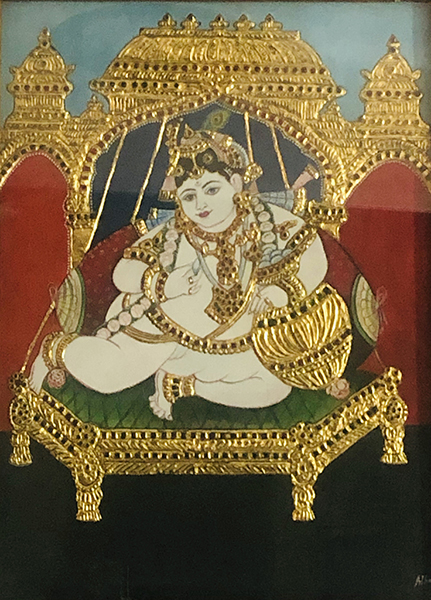Tanjore Painting is one of the most popular forms of classical South Indian painting. It is the native art form of Thanjavur (also known as Tanjore) city of Tamil Nadu, India. Tanjore Painting originated in India during the 16th century, under the reign of the Cholas. Marathas, Nayakas, Rajus communities of Tanjore, Trichi and Naidus of Madurai also patronized Indian Thanjavur Paintings from 16th to 18th century.
The origin of this ancient art form lies in the fabled Vijayanagara Empire (1336-1646 A.D.) which included large areas of present-day Karnataka, Andhra Pradesh and Tamil Nadu. Thanjavur was a part of the kingdom. The Vijayanagara kings were great patrons of all forms of art. It is speculated that this art form began as a method of decorating building interiors – walls and doors. The interiors of palaces were painted with depictions of important events in the king’s reign – coronation, famous battle-field victories and other scenes that the king commissioned, while the wall paintings and murals in temples involved religious themes. Remnants of these wall paintings can still be seen on the walls of the temple of Virupaksha in Hampi the capital of the Vijayanagara Empire, in the temple of Lepakshi in Andhra Pradesh and the temples of Kamakshi and Varadaraja in Kanchipuram. Thanjavur itself has samples of this painting in the interior of the first tier of the gopuram of Periya Kovil of Brihadeeswara. Since access into the gopuram is restricted, replicas of these paintings can be seen in the museum situated in the temple compound. Over time, the technique was used in smaller compositions such as portraiture or the depiction of a religious theme.
Most of these paintings revolve around the theme of Hindu Gods and Goddesses, along with saints. Episodes from Hindu Puranas, Sthala-puranas and other religious texts were visualised, sketched or traced and painted with the main figure or figures placed in the central section of the picture (mostly within an architecturally delineated space such as a mantapa or prabhavali) surrounded by several subsidiary figures, themes and subjects. There are also many instances when Jain, Sikh, Muslim, other religious and even secular subjects were depicted in Tanjore paintings. Since Tanjore Paintings are mainly done on solid wood planks, they are locally known as ‘Palagai Padam’ (palagai meaning wooden plank and padam meaning picture).
Making of Tanjore Painting
There a number of steps involved in the making of a Tanjore Painting, the first involves drawing of the sketch of the image on the base. The base is made up of a cloth, which is pasted over a wooden base. The second step consists of mixing chalk powder with water-soluble adhesive and applying it on the base. Thereafter, the drawing is made and embellished with cut glass, pearls and even semi-precious stones. Earlier vegetable colours and precious gems like diamonds and rubies were used to embellish the portraits. Thin sheets of gold are pasted in relief on some parts of the painting, while the other parts are painted in bright colors. The dense composition, surface richness and vibrant colors of Indian Thanjavur Painting make it unique. The relief work gives them a three dimensional effect. One of the distinguishable features of Tanjore painting is the plumpness in the faces of the idols which exudes the characteristic look in all the Tanjore paintings one comes across.
Although the paintings of Tanjore are deeply entrenched in the cultural past of the place it has originated from, the artists use their skill and imagination to create masterpieces of the art form.


